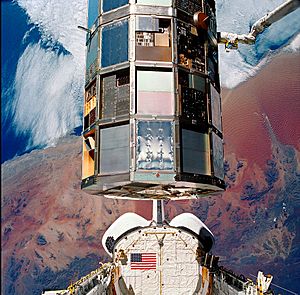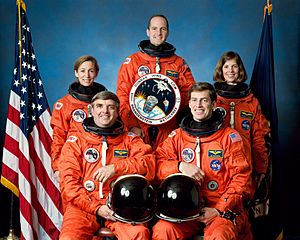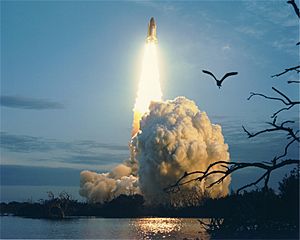STS-32 facts for kids

Columbia retrieves the Long Duration Exposure Facility.
|
|
| Names | Space Transportation System-33 STS-32R |
|---|---|
| Mission type | Syncom IV-F5 (also known as Leasat 5) military communications satellite) deployment LDEF satellite retrieval |
| Operator | NASA |
| Mission duration | 10 days, 21 hours, 0 minutes, 36 seconds (achieved) |
| Distance travelled | 7,258,096 km (4,509,972 mi) |
| Orbits completed | 172 |
| Spacecraft properties | |
| Spacecraft | Space Shuttle Columbia |
| Launch mass | 116,117 kg (255,994 lb) |
| Landing mass | 103,571 kg (228,335 lb) |
| Payload mass | 12,014 kg (26,486 lb) |
| Crew | |
| Crew size | 5 |
| Members |
|
| Start of mission | |
| Launch date | 9 January 1990, 12:35:00 UTC |
| Rocket | Space Shuttle Columbia |
| Launch site | Kennedy Space Center, LC-39A |
| Contractor | Rockwell International |
| End of mission | |
| Landing date | 20 January 1990, 09:35:36 UTC |
| Landing site | Edwards Air Force Base, Runway 22 |
| Orbital parameters | |
| Reference system | Geocentric orbit |
| Regime | Low Earth orbit |
| Perigee | 296 km (184 mi) |
| Apogee | 361 km (224 mi) |
| Inclination | 28.45° |
| Period | 91.10 minutes |
 STS-32 mission patch  Standing: Marsha S. Ivins, G. David Low, Bonnie J. Dunbar Seated: Daniel C. Brandenstein, James D. Wetherbee |
|
STS-32 was the 33rd mission for NASA's Space Shuttle program. It was the ninth flight of the Space Shuttle Columbia. The mission launched on January 9, 1990. This flight was the first time Launch Pad 39A at Kennedy Space Center had been used since 1986. It was also the first time Mobile Launcher Platform-3 (MLP-3) was used for a Space Shuttle mission.
STS-32 was the longest shuttle mission at that time, lasting almost 11 days. Before this mission, only STS-9 in 1983 had lasted as long. On January 20, 1990, STS-32 completed the third night landing in the shuttle program's history. It was also the very first shuttle launch of the 1990s.
The mission was officially called STS-32R. This was because the name STS-32 had been used internally for an earlier mission, STS-61-C. The "R" was added to avoid confusion in tracking data for missions from STS-26 to STS-33.
Contents
Meet the STS-32 Crew
The STS-32 mission had a crew of five talented astronauts. They worked together to complete the mission's important goals.
| Position | Astronaut | |
|---|---|---|
| Commander | Daniel C. Brandenstein Third spaceflight |
|
| Pilot | James D. Wetherbee First spaceflight |
|
| Mission Specialist 1 | Bonnie J. Dunbar Second spaceflight |
|
| Mission Specialist 2 | Marsha S. Ivins First spaceflight |
|
| Mission Specialist 3 | G. David Low First spaceflight |
|
Getting Ready for Launch
Before STS-32 could launch, Launch Complex 39A needed a lot of work. This launch pad was updated after its last use in 1986. NASA made many improvements to make it safer and more efficient.
- Safety Upgrades: The system for astronauts to escape in an emergency was improved.
- Shuttle Room: The area where the shuttle's cargo is loaded was made better.
- Water Systems: Anti-freeze protection was added to water systems.
- Debris Traps: Special traps were installed to catch debris when fuel was loaded.
- Weather Protection: More features were added to protect against bad weather.
- Heater Umbilical: A new cable was added to power heaters for the solid rocket booster parts.
Mobile Launcher Platform-3 (MLP-3) also got a big makeover. This platform is very old, dating back to the Apollo program. For the shuttle, its umbilical tower was removed, and its exhaust holes were changed. Electrical and mechanical systems were also updated.
Mission Highlights
STS-32 launched from Kennedy Space Center (KSC) in Florida on January 9, 1990. The launch was originally planned for December 18, 1989. However, it was delayed to finish the upgrades on Launch Pad A. The next launch attempt on January 8, 1990, was canceled due to bad weather. The Space Shuttle Columbia weighed about 116,117 kilograms (256,000 pounds) at launch.
Key Goals of the Mission
The main goals of STS-32 were:
- To launch a military communications satellite called Syncom IV-F5 (also known as Leasat 5).
- To bring back NASA's Long Duration Exposure Facility (LDEF) satellite.
The LDEF satellite's return had been delayed for four and a half years. This was due to changes in mission schedules and the Challenger disaster in 1986.
Satellite Deployment and Retrieval
The Syncom IV-F5 satellite was launched on the second day of the flight. A special rocket motor then pushed it into a geosynchronous orbit. This is an orbit where a satellite stays over the same spot on Earth.
On the fourth day, astronaut Bonnie J. Dunbar used the shuttle's robotic arm, called the Canadarm, to grab the LDEF satellite. Getting the LDEF back was very important. The sun's activity had made the atmosphere around LDEF thicker. This was causing the satellite to slowly fall out of orbit faster than expected. Experts worried that if LDEF wasn't retrieved soon, it would fall too low for the shuttle to reach safely. It might even burn up in Earth's atmosphere by February 1990. Because of this, the exact launch time for STS-32 was decided only about 12 hours before liftoff. This allowed them to use the latest tracking data for LDEF.
Studying the LDEF Satellite
The crew spent four and a half hours taking pictures of the LDEF. This satellite was a 12-sided cylinder, about the size of a small bus. It held 57 different science, technology, and research experiments. After the photo survey, the LDEF was placed safely in the shuttle's cargo bay to be brought back to Earth.
Longest Shuttle Mission
NASA also wanted to study how long periods of zero gravity affected the astronauts. They wanted to see how it impacted their ability to land the shuttle after a long mission. STS-32 set a new record for shuttle missions, lasting almost eleven days. Later, a special kit was made to allow the shuttle to stay in orbit for up to 16 days. This kit was first used on Columbia's STS-50 mission in 1992.
Filming in Space
The retrieval of the LDEF was filmed with an IMAX camera. This footage was used in the 1994 IMAX film Destiny in Space. Other Earth observation footage from the camera also appeared in the 1990 film Blue Planet.
Landing Back on Earth
Columbia landed safely on January 20, 1990. It touched down at 1:35 a.m. Pacific Standard Time on Runway 22 at Edwards Air Force Base in California. The shuttle weighed about 103,571 kilograms (228,338 pounds) when it landed. It rolled for about 3,271 meters (10,732 feet) and took 62 seconds to stop. The orbiter was then returned to Kennedy Space Center on January 26, 1990.
Experiments on Board
Besides the main satellite, STS-32 carried several scientific experiments in its mid-deck. Some of these had flown on earlier shuttle missions. These experiments included:
- Characterization of Neurospora Circadian Rhythms (CNCR)
- Protein Crystal Growth (PCG)
- Fluid Experiment Apparatus (FEA)
- American Flight Echocardiograph (AFE)
- Latitude / Longitude Locator (L3)
- Mesoscale Lightning Experiment (MLE)
- IMAX camera
- Air Force Maui Optical Site (AMOS) experiment
Wake-Up Calls from Space
NASA has a fun tradition of playing music to wake up astronauts in space. This started during the Project Gemini missions and was first used to wake up a crew during Apollo 15. Each song is chosen carefully, often by the astronauts' families. The songs usually have a special meaning to an astronaut or relate to their daily tasks.
| Flight Day | Song | Artist/Composer |
|---|---|---|
| Day 2 | "What's More American?" | Bing Crosby |
| Day 3 | "The Banana Boat Song" parody | |
| Day 4 | "Let It Snow" parody | |
| Day 5 | "Hello Dolly" parody | |
| Day 6 | "Attack of the Killer Tomatoes" | |
| Day 7 | "Notre Dame Victory March" | |
| Day 8 | "Bow Down to Washington" | University of Washington |
| Day 9 | "Glory, Glory, Colorado" | University of Colorado |
| Day 10 | "Danny Boy" | Larry Bird |
| Day 11 | "Washington and Lee" | Washington and Lee University |
| Day 12 | "Born to Be Wild" | Steppenwolf |
| Day 13 | "Anchors Aweigh" | Charles A. Zimmerman |
Mission Patch Symbolism
The STS-32 mission patch has three stars on the left and two stars on the right. These stars represent the mission's number, 32, in the Space Transportation System sequence. The shuttle on the patch is shown upside down. This design shows how the shuttle had to approach the LDEF satellite. The LDEF had dropped to a very low orbit. Because the atmosphere was thicker at that height, the shuttle couldn't catch up from below as usual. Instead, it had to reach LDEF from above.
Images for kids





